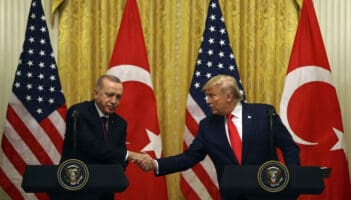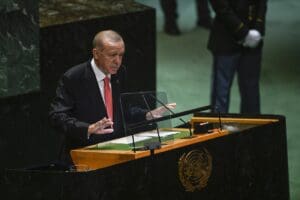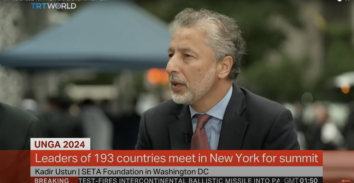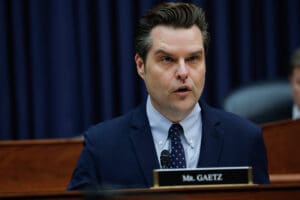Engagement and Avoidance in the Middle East
During the Civil Rights Summit that took place in April at the LBJ Presidential Library in Austin, Texas, there were a lot of debates about comparisons of President Barack Obama and President Lyndon Johnson. The domestic and foreign policy records of these two presidents (of course by taking into account the fact that Obama has still more than two years in office) were compared by many analysts of American politics. Of course for foreign policy experts, in terms of LBJ, the major issue was the quagmire in Vietnam. And for Obama’s foreign policy the main issue was the avoidance and indecisiveness in foreign policy which sometimes is complemented by very open reluctance to engage in the higher echelons of power.
This comparison was not something new. Since the first years of the Obama administration there were constant references to the Vietnam War and how the main actors of U.S. foreign policy made the decision to go to war with Vietnam and how they failed in their projections and estimates. It was a known fact that Johnson’s successes in domestic policy and historic acts were overshadowed by a failure in foreign policy. Not to fail in the same way like Johnson has been almost a goal for the Obama foreign policy. Obama and his team understood that public opinion has been heavily affected by “war fatigue” after two lengthy wars in the Middle East and avoiding any more conflict in the region has become priority.
Even in the announcement of the pivot to Asia, then Secretary of State Hillary Clinton wrote that U.S. had lost 10 years in two conflicts and totally ignored the new center of gravities of world geopolitics, Asia. However as the Arab Spring unfolds, the center of attention somehow unwillingly moved back to the Middle East. President Obama after some hesitation supported the people’s movement in Egypt, and after much deliberation decided, “to lead from behind” in Libya in order to be “on the right side of the history.” In the first months of the uprising in Syria, the U.S. position was supportive of demonstrators in Syria and President Obama himself stated that Assad has no more legitimacy to rule the country and thus “for the sake of the Syrian people, the time has come for Syrian President Bashar al-Assad to step aside.” Obama later made another strong statement more than one year after the demonstrations and said that “We have been very clear to the Assad regime, but also to other players on the ground, that a red line for us is we start seeing a whole bunch of chemical weapons moving around or being utilized. That would change my calculus.” However, even after the use chemical weapons, and death of almost 200,000 people with conventional weapons, the administration has failed to come up with a solution to halt the bloodshed in Syria. As the conflict in Syria turned into a civil war the analogies of Vietnam and a strong avoidance from any form of interference to the issue become more prevalent.
However this over-avoidance and eagerness to avoid a Johnsonian tragedy in foreign policy is causing another tragedy in the Middle East. Yes, contrary to Johnson’s failure, it is not happening as a result of direct U.S. military intervention but it is happening as a result of indecisiveness for action and creating a major failed state in the midst of the Middle East. Organizations like the Islamic State of Iraq and al-Sham (ISIS) meanwhile are finding a breeding ground in the conflict and in the absence of any form of mechanism to stop the sectarian policies of the Maliki administration, ISIS started to gain further supporters in Iraq as well as in different parts of the world.
In the midst of all these problems Secretary of State John Kerry was embarked upon another diplomatic tour of the Middle East. At his first stop Kerry visited President Abdel-Fatah el-Sissi of Egypt, which was interpreted as an open endorsement of Sissi by the U.S. administration. It was a 180 degree turn from the statements of former Secretary of State Condoleezza Rice, who in her address in Cairo said, “The stability we thought we were buying for 60 years at the expense of democracy gave us neither stability nor democracy.” The U.S. had one more time picked stability in Egypt. Such a show of support for a coup leader who is responsible for the death of thousands, of course impacts the effectiveness of Kerry’s words in Iraq when he calls Maliki to form a more inclusive government. It puzzles many in the Middle East whether the U.S. has a real policy in the Middle East as of now. The lack of enthusiasm or willingness to engage is very much obvious.
More than five years after becoming president, Obama now has a Middle East that is more unstable and unpredictable. The situation in Iraq is approaching a full scale civil war again, which now also includes another civil war in Syria. In Egypt, there is a younger and more authoritarian leader in power. Peace efforts that few were optimistic about failed one more time. On top of it there are millions of refugees that could destabilize neighboring countries and there is an organization called ISIS which is transforming itself from being a neo-al-Qaida to a neo-Taliban in Iraq and Syria. Although the Obama administration does not want any form of engagement in the Middle East and to pursue “a foreign policy that starts at home,” if U.S. interests and allies in the region felt threatened by the developments, the U.S. had no chance but engage in the issues in one way or another in order to contribute for the resolution of conflict. Overt reluctance and a lack of appetite to avoid a Johnsonian tragedy will in the long run create its own type of tragedies.
This article was originally published in Daily Sabah on June 26, 2014.




















